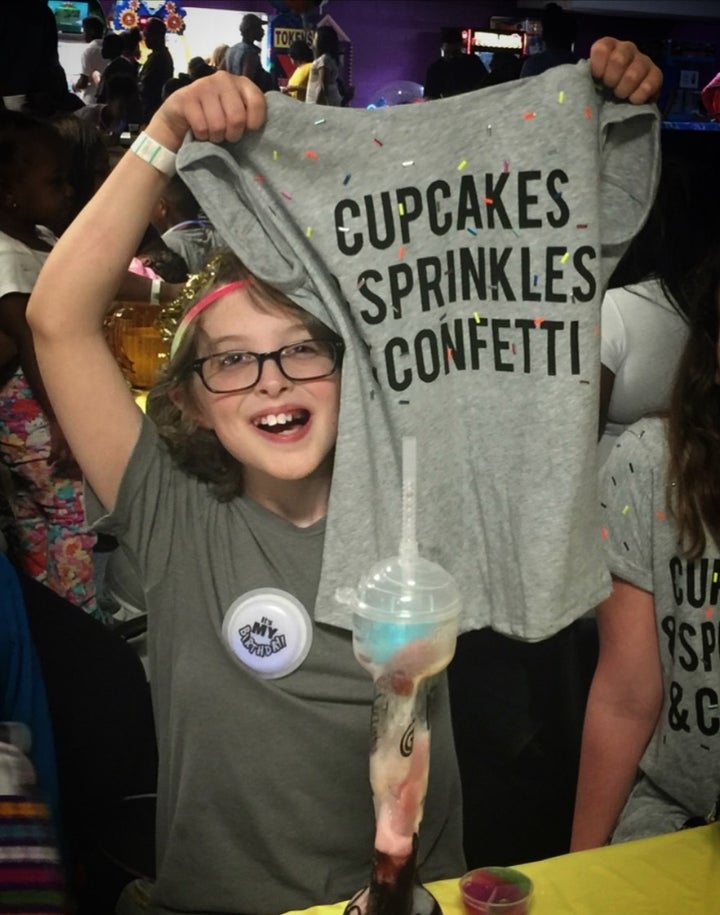Dear Trans Kids,
I’m writing to you, but not just to you. I’m also writing to all the rainbow kids, whatever you call yourselves, however you identify. I am writing to you as an American-born, white, straight, cisgender, liberal Christian mother of three with a good education, a good job, three good kids, and a good husband. What do I have to offer you? My unconditional love and my unwavering support in a battle for your rights ― a battle that with “45” in office is only just beginning.
You don’t know me, but I’ve been advocating for you for the past nine years.
My youngest child is a boy who identifies as gender creative. I read some of my writing about the moment I knew he was “different” here.
I am an advocate for the LGBTQ+ community, and specifically for gender non-conforming/gender creative and transgender kids. I founded and run a playgroup for transgender and gender creative kids, and discussion group for parents. I contact my local representatives. I write and speak out whenever I can. I love opportunities to educate.
Officially, the term gender creative is an adjective, coined by the brilliant author, and developmental & clinical psychologist, Diane Ehrensaft, Ph.D. It simply means: People (often children) who don’t conform to traditional or stereotypical gender norms; a developmental position in which the child transcends the culture’s normative definitions of male/female to creatively interweave a sense of gender that come neither totally from the inside (the body, the psyche), nor totally from the outside (culture, others’ perceptions), but resides somewhere in between. Sometimes they are referred to as gender non-conforming.
My first two pieces published last summer on Huffington Post were When Your Fourth Grade Son is Called Gay, and then, Why I Refuse to Apologize for My Son Wearing a Dress. Then I published an open letter on my blog that I wrote to Justice, the tween girls clothing store, for welcoming my then 10-year-old son to shop in their store, use the “girls” dressing rooms, and for making the experience seamless and natural in a very tense environment post North Carolina’s notorious anti-LGBTQ+ law, HB2. That letter went viral overnight, garnering over 22,000 shares by morning, and 48,000 shares by afternoon, something I was neither expecting nor prepared for.
When I wrote those blog posts, I was speaking out on behalf of my son, but also, on behalf of all the gender creative, gender variant, gender non-conforming children I knew had to be out there.
For lack of better terminology back then, I remember both “effeminate” boys and “butch” girls from my own childhood ― as early as elementary school. They were teased and harassed mercilessly. By middle school it only got worse. They were plagued with names such as “faggot,” “gay,” “pansy,” “dyke,” “lesbo,” and more, regardless of whether or not they were sexually identifying yet. It was just about the worst label to have attached to you if you were of my generation, especially during the early-mid ‘80s when the AIDS crisis hit, when ignorance and paranoia fueled our sex culture.
Regardless of whether these kids were actually on, or grew to identify as part of the LGBTQ+ spectrum or not, they were more often than not gender non-conforming. The ones who weren’t were usually pretending. Pretending to be cisgender. Or straight. Those are probably the top two things that are somewhat easier to fake than other outward appearances.
I had several brave gay friends who came out in the ‘80s. For a few of them, it was both a huge relief and disastrous. Family relationships were torn apart. Friendships were lost. Some of them were kicked out of their homes because their parents refused to have someone gay living under their roof. But the relief that came with no longer having to pretend to be straight was well worth their mental health for the rest of their lives.
Though the pieces I’ve written and spoken about were not about gay people, but rather transgender and gender creative people, they seem oddly more relevant today than they did when I first began writing them nine years ago. By the tender age of 2 1/2, my youngest child said to me, “Mommy, you know I’m only a boy because of my parts, right?” I didn’t know anything about transgender people back then, let alone that I’d one day need to fight for these people’s basic human rights.
I cued in and listened to my young son. I knew this was a profound statement from such a small child, and I knew it wasn’t nonsense. It also aligned perfectly well with his toy and play preferences. Never one to show any interest in rough & tumble play, or trucks and cars, my son instead favored princess dress up, Barbies, and gentle, imaginative play. I began reading and researching as much as I could about “effeminate” boys. Eventually I happened upon Lori Duron’s blog, Raising My Rainbow, and the heavens opened up and angels proclaimed hallelujah. Finally, I found a resource. Her family was on the opposite coast of the United States from me, but her child was close in age to mine, and someone with whom I could identify. I was not alone, nor was my child.
As the years passed, I decided to try something that I never saw other moms doing. I decided to let my son be; to not try and change him. By playing with stereotypical “girls” stuff, he wasn’t hurting anyone. There was no harm. This is just who he was, plain and simple.
I had a couple of mom friends with young boys who liked to play dolls and princess dress up with my son. They were fine with it until about age 4, when the moms didn’t find it so cute anymore. Which I always considered silly. These boys were 4 and 5. They were engaging in natural play. “At the very ‘worst,’” I thought, “these kids are learning how to be gentle, loving, present fathers.” But the other two moms didn’t agree. They felt that allowing these boys to express a more feminine side would lead to their “becoming gay,” or lead them to be bully bait. One parent went so far as to throw away all her daughter’s used ballet costumes in an effort to dissuade her younger son from dressing up in them anymore. He was devastated and cried over this loss. His father yelled at him, told him to “man up,” and quickly replaced his beloved hand-me-down ballet costumes with footballs and army gear.
I wanted to go a different route. I decided I would never shame my son for who he was. After several years, it was obvious that he was more feminine than masculine to both my husband and me. We knew that the majority of society would not embrace that. And we did do our due diligence in buying him plenty of “boys” stuff. But he was never interested. We also felt that if we shamed him into the closet, the long-term damage to his life would be much worse than if he had to endure some short term, kid-type teasing or bullying. Kids all seem to be picked on for something or another. And even if our child tried to “man up,” he just wasn’t able to hide the feminine tendencies. He was fragile and tiny with delicate features, very much unlike his older brother who was solid, robust, and hyper-masculine.
We decided that he would grow up encouraged to be himself, knowing that he was loved unconditionally. He would not just be accepted, but celebrated, just as he was, and however that changed over time.
Over the past year, I have taken every opportunity to write about, or speak out against discrimination of marginalized people. I recently had a male acquaintance of my son approach me and say, “Um, I’m not trying to be rude, but, your son is wearing a pink flower headpiece in his hair.”
“Yes,” I replied with a smile. He’s growing his hair out long and that headband is one of his favorites. It keeps his hair out of his eyes.”
“But,” the child continued, “I just think it’s... um... it’s...um... it’s just... WEIRD.”
He said “weird” with that look on his face that implied not curiosity, but disgust.
I replied, “Actually, I think the word you’re looking for is not weird, but brave.”
He looked confused.
I continued, “do you have any idea how brave a 5th grade boy has to be to wear pink flowers in his hair and be taken seriously? Do you have any idea how brave a 5th grade boy has to be to wear a headpiece in his hair with huge pink flowers and come to school knowing that he will be teased and picked on by just about everyone? And yet he wears it anyway because he likes it and that’s all that matters. That is nothing short of being extremely brave. Young man, let me ask you: are you brave enough to come to school wearing pink flowers in your hair?”
The response of crickets let me know my point was well-understood.
I try to find these moments in every day life and educate others, or at least help them see a different viewpoint.
My son just celebrated his 11th birthday this week. It wasn’t much of a celebration, because a bad case of pneumonia has taken him down for about a week so far. But still he managed to make an appearance at his birthday party which consisted predominantly of 5th grade girls. It was actually the first birthday party where his friends gifted him all the “girly” stuff that he asked for. My Little Pony plushies. A tiara. Pink slippers. A shirt that reads All Kinds of Fabulous. Another floral headband for his growing hair. A “twin” shirt from a good female friend so that they can be twins at school on the same day.

Charlie’s 11th birthday party, receiving a “twin” shirt from a great friend.
He’s still young, but he has the courage and confidence to be himself regardless of the teasing that inevitably occurs. This puts him light speed ahead of other gender diverse kids who are not allowed to explore this side of themselves until adulthood ― and by then, they’ve spent most of their formative years living a lie. I know many of these people. The majority of them are prone to self-destruction in adulthood. Sadly, some of them have committed suicide. I’ve received multitudes of e-mails from transgender and gender diverse adults who have told me their stories, and how much better they believe they would’ve fared in the real world if only their parents had been accepting of their true self, if only they had learned during their youth to build self-confidence instead of building walls or learning hiding techniques.
My son may reveal to me that he’s transgender. He may reveal that he is gender creative forever. He may be agender. Eventually he may reveal that he’s gay, bi, or asexual. He may settle into being cisgender (though it hasn’t looked that way for pretty much ever.) Regardless of the outcome, he knows he is loved and accepted and celebrated for exactly who he is.
To all the trans kids, and all the rainbow kids, no matter how you identify, I want you to know that you are seen, you are heard, and you are worth celebrating. This hateful, ignorant, divisive, destructive administration will be gone soon enough. You will be around much longer, and it’s not worth it to hide. Do what you can to be brave, be yourself, be strong. I’m just one small advocate. You may have no idea, but there are armies of us out there, and we will spend the rest of our lives fighting for your right to live authentically.
Originally published at www.gendercreativelife.com
